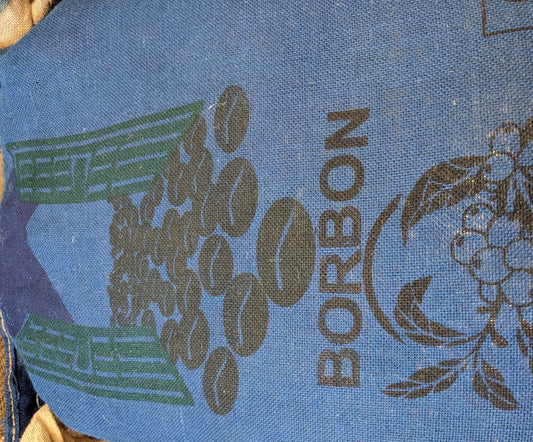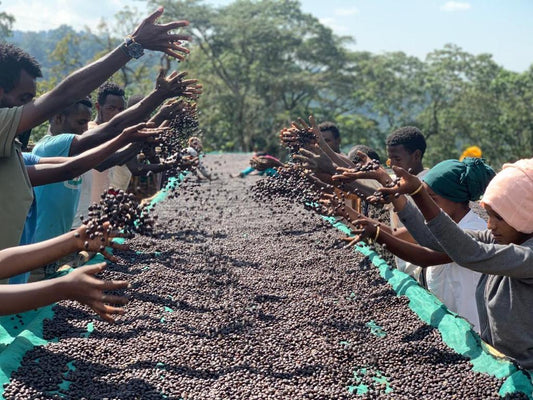10,000.
That's how many different and unique varietals are estimated to be growing in Ethiopia today.
Some estimates even put that number at up to 15,000.
Whatever way you look at it, that's a lot of different coffees.
And what's more....we know pretty much nothing about the vast majority of those varietals.
So what is Ethiopian Heirloom coffee?
The coffee growing industry in Ethiopia is very different to coffee in other countries.
There are so many different varietals growing both wildly and commercially in Ethiopia, that most aren't yet named.
Instead, they're collectively referred to as Ethiopian Heirloom or a smattering of other terms (but more on that later).
A lot of coffee farmers and producers in Ethiopia, even small ones, will have many different varietals growing alongside each other. And many will bundle all of them together into collections of more generally labelled Heirloom lots.
So Heirloom is used as a generic term for any unknown varietal(s).
Even when you find really high quality, specialty focused producers, they don't often separate their harvests out into single varietal lots.
This Ethiopian natural from Limu for example, contains a mix of 4 different varietals.
Of course, there are others like this Natural from Nguisse Nare and this one from Guji that are separated into single varietal lots, but many more are either collections of multiple known varietals, or collections of unknown varietals that get bundled together as Heirloom.
What makes Ethiopian Heirloom coffee special?
Ethiopian Heirloom coffee is special because of its incredible diversity.
Ethiopia is also the birthplace of coffee and where all coffee varietals descended from.
Each region in Ethiopia has its own local Heirloom varietals, and that means cup profiles can be very different from region to region.
Ethiopian coffee also grows at some of the highest elevations, meaning that the cherries develop more slowly. You can read more about how elevation effects coffee growing here.
What does Ethiopian Heirloom coffee taste like?
There's a lot of diversity in Ethiopia's 10,000+ varietals.
If we had to make a one general statement though, we'd probably say this:
Ethiopian Heirloom coffee is usually very fruity and/or floral, depending on how it's been processed. Heirloom lots tend to be higher in sweetness and have a broad range of acidity thanks to the impressive altitude of most speciality coffee found here.
If you find Ethiopian coffee roasted more on the medium to dark range, you might get some chocolatey notes. And actually it's commonly used in a lot of espresso blends for that reason.
But usually, good single origin Ethiopian Heirloom lots tend to be a mixture of berry fruits, stone fruits, citrus and the full range of florals and even bergamot and green tea notes.
Cup profiles can vary a lot from region to region, depending on the specific Landrace varieties growing in any particular area, and processing method also plays a role.
A washed Yirgacheffe for example will usually be full of florals and stone fruits, whereas a Guji natural processed might be more sweet with lots of berry notes.
If you're ready to dive in and explore some Ethiopian Heirloom coffees for yourself, our handy Explore: Ethiopia pack is a really easy and convenient way to taste a sample of 3 different Ethiopian natural coffees from different parts of Ethiopia.
Ethiopian Heirloom Vs Landrace - What's the difference?
The important distinction, is that Landrace coffees are unique to a particular area, whereas Heirloom coffees aren't.
In Ethiopian coffee, the word "Heirloom" is usually used as a good catch all term.
Really, most Ethiopian coffees could be called Heirloom varietals.
But there's 2 different groupings within Heirloom.
Landrace and JARC.
JARC stands for the Jimma Aggrcultural Research Center.
Part of what JARC does, is to breed and develop new genetic verietals, specifically for commercial use.
That might involve selectively breeding for yield, or for resistance to particular pests or diseases.
Ethiopian Landrace is the collective term for all the thousands of local coffee varietals that have evolved naturally in the mountains and forests through Ethiopia.
An Ethiopian Landrace lot from Sidamo, for example, might contain dozens of different varietals that are all unique to that particular local area.
What's being done to document Ethiopian coffee varietals? And will we always have to use collective terms like Heirloom or Landrace?
As specialty coffee progresses, more and more work is bring done to study and understand the thousands of wild coffee varietals growing in the forests of Ethiopia.
There's a lot of research projects underway in Ethiopia to study and document the estimated 10,000+ different wild varietals of coffee - many of which have evolved perfectly to their specific local agricultural conditions, climate and ecology.
Both the Ethiopian Institute of Agricultural Research (EIAR) and the Jimma Agricultural Research Center (JARC) have long been working on developing better understanding of the many wild arabica varietals within Ethiopia. Ultimately their goal is to provide farmers with better varietals, more resilient and productive seeds as well as education on disease, quality control and conservation.
Since 2021, World Coffee Research has worked alongside EIAR and JARC to continue to develop this understanding, in a bid to support farmers and producers with improved varietals and better plants that can benefit local producers.
Are there other incredible varietals like Gesha waiting to be discovered in the forests of Ethiopia?
Almost certainly, yes.
If you know the story of Gesha and its recent "rediscovery", you'll know that Gesha itself can trace its roots back to the forests of Ethiopia.
Gesha is now the most famous and still probably the most sought after Ethiopian Landrace varietal.
But it certainly wont be the last "rediscovery" we see in specialty coffee.
The World Coffee Research, alongside many other groups, are highly active in Ethiopia to identify, document and preserve as many varietals as possible.
The next record breaking coffee varietal could well be waiting to be discovered in the mountain forests of Ethiopia.





